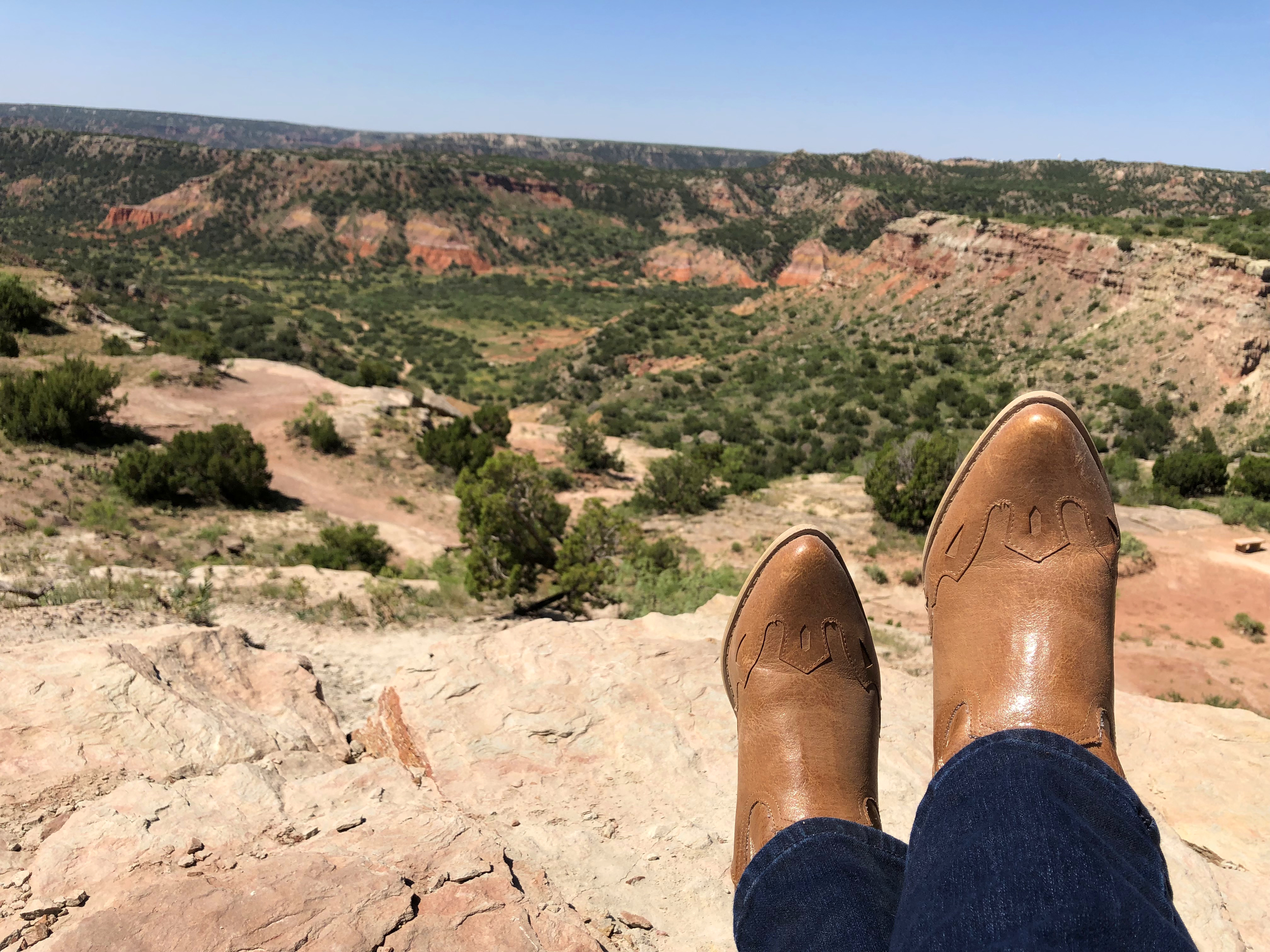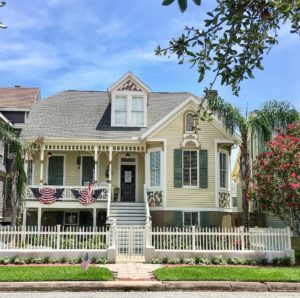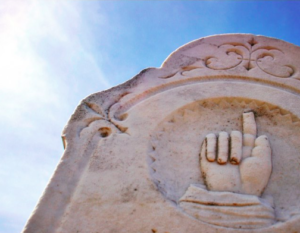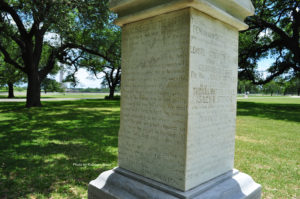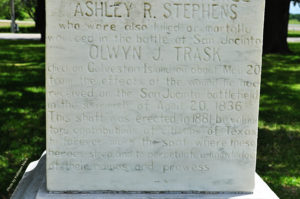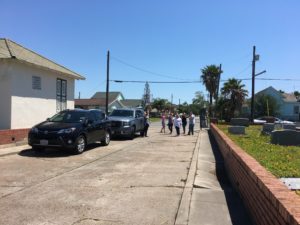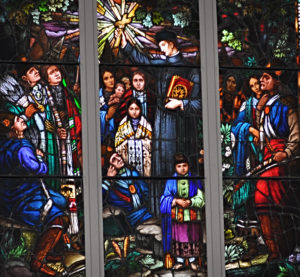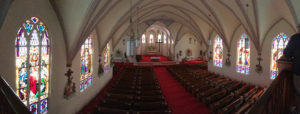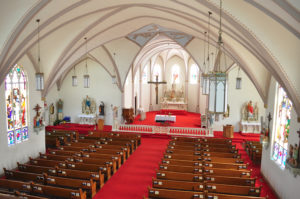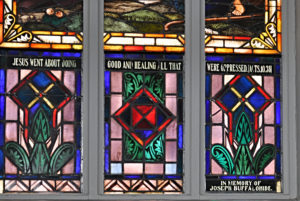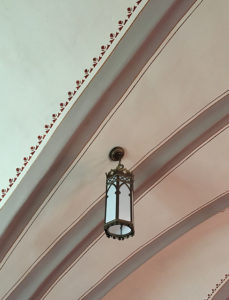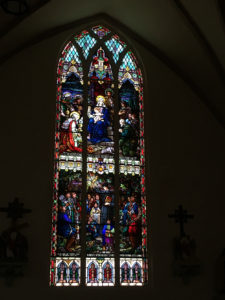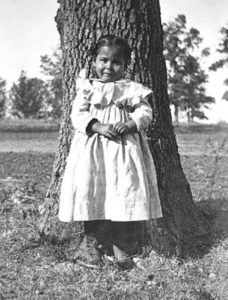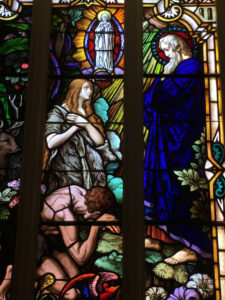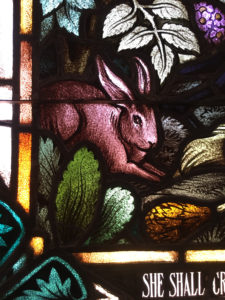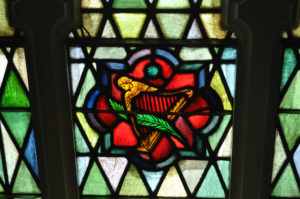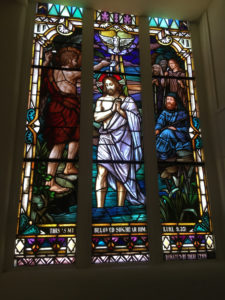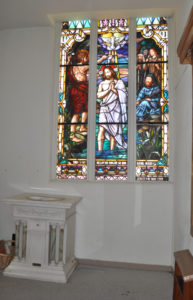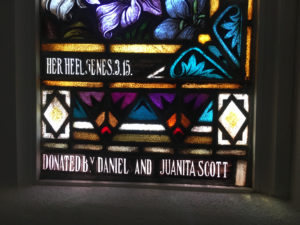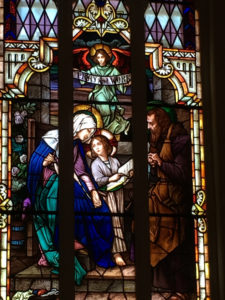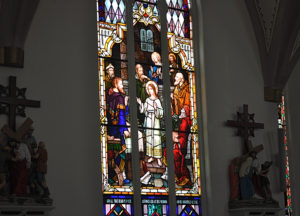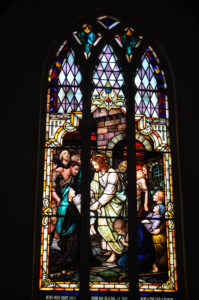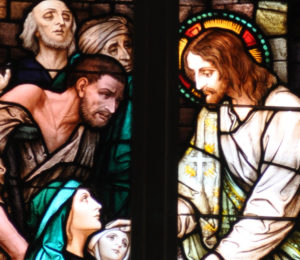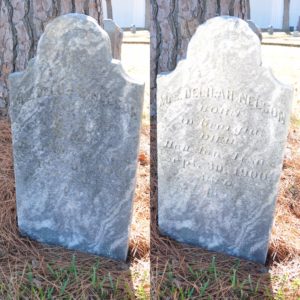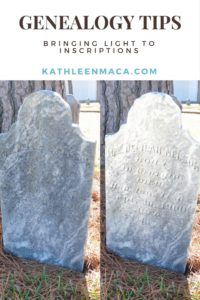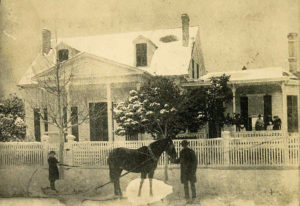Pointing the Way
When I give cemetery tours or workshops I get a lot of questions about the symbolism of different hand portrayals on gravestones.
An index finger pointing up symbolizes the hope of heaven. Knowing this causes some raised eyebrows when visitors spot any markers with a downward pointing finger.
Not to worry…it doesn’t mean the person is going ‘in the other direction!’ It just represents God reaching down for the soul (or an unexpected death).
Phew! There now, don’t you feel better?
Wounded at San Jacinto – Died at Galveston
I wanted to write a post for Memorial Day that tells the story of someone with Galveston ties who gave their life in battle. The challenge was that there are so very many stories to tell. In the Broadway Cemetery complex alone there are veterans from every war from 1812 forward. Of course, not all of them lost their life in the service, and many of those who did have stories that are well-known.
So I decided to go with a little more obscure story with Galveston ties that many locals may not have heard.
When people visit the San Jacinto Battleground State Historic Site, they usually visit the impressive star-topped monument and possibly the USS Battleship Texas. But are you aware there are actually TWO cemeteries on the grounds?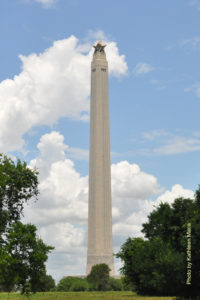
The most visible of the two is close to the battleship, and known as San Jacinto Battlefield Cemetery. It is where the handful of Texans killed in the battle were buried near the Texan Army camp. Buried there are Dr. William Junius Motley, Sgt. Thomas Patton Fowle, Lt. George A. Lamb, Lt. John C. Hale and privates Lemuel Stockton Blakey, Mathias Cooper, Ashley R. Stevens, Benjamin Rice Brigham and Olwyn Trask.
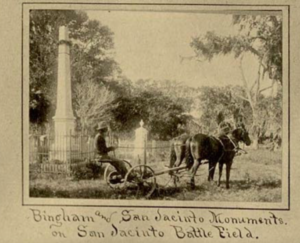 A monument called the Brigham Monument was erected at the gravesite in 1881.
A monument called the Brigham Monument was erected at the gravesite in 1881.
Taking the time to read the lengthy inscriptions, the word “Galveston” (of course) caught my eye.
“Olwyn J. Trask…died on Galveston Island… of wounds …received at the San Jacinto Battlefield…”
This is how it begins, folks. I see something like this and I’m off, down the rabbit hole of research. Olwyn’s story took me on a complicated journey that involved his family, his unlikely demise, and even the beginnings of Baylor University. But here, I’ll just concentrate on his story.
Olwyn Trask’s sister Frances was a brilliant educator in Texas. By some accounts Olwyn, a recent college graduate, was sent to Texas during the Revolution by their family in Massachusetts to bring her home. Because he arrived in the Spring of 1835, however, it is more likely that he came to join her and their cousins (the Dix family) to seek out business prospects.
Soon after spirited 21-year-old reached Galveston though, he impulsively joined the Texas Army to fight for independence from Mexico.
He became a member of Captain William H. Smith’s Cavalry Company, after General Sam Houston himself witnessed his horsemanship skills in lassoing a young mustang.
On April 20, 1836, the day preceding the famous Battle of San Jacinto, he was one of 80 men under Colonel Sherman who skirmished against the Mexican Army. Only two men in the Texan ranks were wounded, but Olwyn’s were mortal.
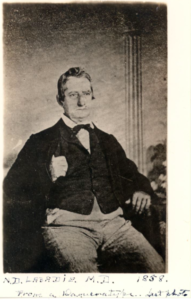
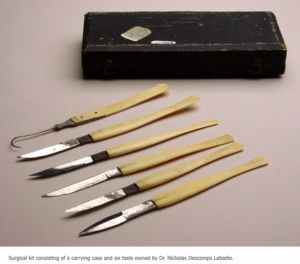 Nicholas Descomps Labadie was an assistant surgeon in the Second Regiment Volunteers under Anson Jones, and treated Trask when he arrived back at camp. The conditions were primitive, and resources limited.
Nicholas Descomps Labadie was an assistant surgeon in the Second Regiment Volunteers under Anson Jones, and treated Trask when he arrived back at camp. The conditions were primitive, and resources limited.
Olwyn was transported to Galveston on a boat with Texan President Burnet and others, where he was to receive further treatment.
The following extract of a letter from New Orleans furnishes details of Olwyn’s fate:
“I called on General Houston yesterday, to ascertain particulars relative to Olwyn J. Trask; he says that he lies dangerously wounded at the Fort at Galveston Island. His thigh was broken in a charge made by 80 of our calvary on about 250 Mexicans, on the 20thof April, in which he behaved most gallantly. He fell from his horse when the ball struck him, but was almost instantly seen again supporting himself on one leg by his horse and had the satisfaction to kill the man who shot him. This was confirmed by one of the aids of General Houston, then present, who remarked that he was in a position to see the whole of it. He said that after Olwyn had laid the man dead at his feet, he sprang on his horse again, in the midst of the enemy’s cavalry, his own corps having retired and immediately urging him to his utmost speed, cutting his way through the ranks, and brandishing his sword at everything that opposed him, when, as the Aid remarked, they seemed to open for him to pass, and he entered the camp with his leg swinging like the pendulum of a clock.”
Olwyn’s thigh bone had been shattered. It was generally believed among those present that if he had received expert medical attention from the start he might have lived. The makeshift facilities are blamed for his demise about three weeks after the battle.
Upon his death he was buried with his comrades “with all the honors that could have been paid to the Commander in Chief; all the troops were under arms, and the officers of the Navy joined in the procession and minute guns were fired during its progress to the place of burial.”
Olwyn J. Trask’s name and gallantry were so revered in his home state of Massachusetts that young men went so far as to legally change their name to his.
In the years that followed, a community cemetery grew around these graves, but now part of the 10-acre site is partially covered by a parking lot for the battleship.
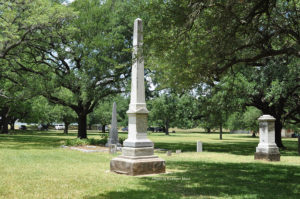
The deed records of Harris County shows that on November 2, 1837, Frances J. S. Trask, Olwyn’s sister, was living at Independence, Washington County, Texas and was on that day appointed representative of Israel Trask of Massachusetts, who was heir to the property of his deceased son. She was awarded the 640 acres of land due Trask’s services at San Jacinto, and used some of it to build a school. This school was the root of what would eventually grow into Baylor University.
Memorial Day seems an appropriate time to remember this young man,
and so many others, who have given their lives fighting for their beliefs and country.
Galveston’s Tie to Britain
Happy Royal Wedding Day!
Galveston and its port have long had a prosperous working relationship with Britain.
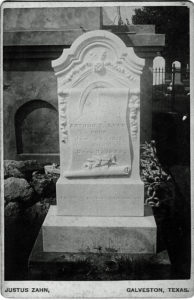
Arthur Thomas Lynn (1812-1888), who was described as remarkably handsome, came to Galveston from England while Texas was still a republic. He was appointed consul general for Great Britain in 1850, and was a beloved member of the community for the rest of his life.
This wonderful cabinet card photo of his grave marker was taken by local photographer Justus Zahn (1847-1918), and appears in my book “Galveston’s Broadway Cemeteries.” The marker is still visible and in Galveston’s Trinity Episcopal Cemetery.
Texas Country Reporter Visits Galveston Cemeteries
There’s nothing that’s more fun than when someone shows an interest in what you do (O.K., maybe a couple of things – but it’s right up there!)…so I was thrilled to be contacted by the television show Texas Country Reporter to talk about the historic cemeteries in Galveston.
This particular show focuses on the people of Texas more than the places, so there were more questions about me than I’m accustomed to…but you better bet that we ended up talking about Galveston history just the same!
I was originally contacted by one of the producers, and we exchanged a few rounds of information via email and by phone. Once the shooting schedule was set I was given a date that my segment would be shot.
What we see when we watch TCR episodes is a series of short interviews, but there are hours of work (and miles of travel) that go into producing each one.
When I asked Quintin, the energetic young producer in charge of my shoot, how the logistics of shooting so many stor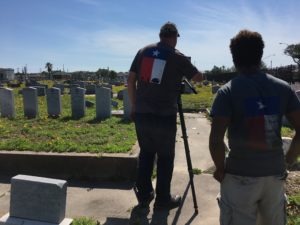 ies come together, he explained that there is more than one team.
ies come together, he explained that there is more than one team.
The crews group their shoots by area of the state, then line up times each subject has available.
Two sets of production teams are sent out to begin filming separate story segments for the show. After initial footage is shot, the hosts join them for their portion and then leave to join the other team.
Once the twosome in charge of producing and shooting the Galveston segment had time t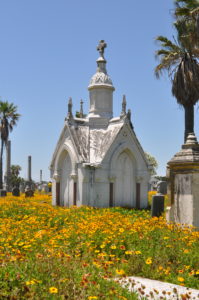 o get the bulk of footage with me in the cemeteries, the show hosts arrived to film their part – which took about an hour.
o get the bulk of footage with me in the cemeteries, the show hosts arrived to film their part – which took about an hour.
After the hosts finish, they left to meet up with the other producer/camera team to film their part of another story.
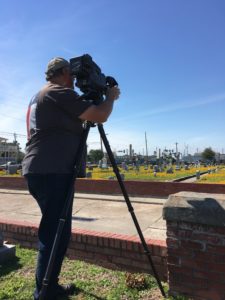 These two teams kind of “tag team” doing stories for a week, and then return to the office to edit the following week while another set of teams goes out. The process is obviously a well-oiled machine.
These two teams kind of “tag team” doing stories for a week, and then return to the office to edit the following week while another set of teams goes out. The process is obviously a well-oiled machine.
Quintin and Dan met me at the Broadway Cemetery District to go over ideas for information to include and begin shooting some “B roll” footage. “B-rolls” consist of footage edited in around the main portion of the segment to complement and fill it out.
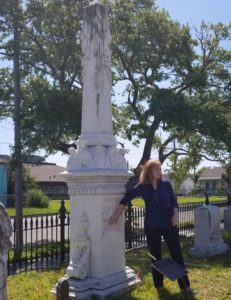
I had sent out a note to some friends a few days prior that we would need some “faux tour-takers” when the crew needed shots representing the tours that I give at the cemetery, just before noon, and luckily I have great friends and a super sister who braved the heat to join us for a little over an hour. A HUGE thank you to all of them!!
After that, the show hosts Bob and Kelli Phillips arrived. If you watch the show, you will be happy to know that they are just as sweet and thoughtful as they appear on TV.
The producer and I  had figured out ahead of time some of the information to include, but the couple had many of their own questions as well. Sitting on the wall of Trinity Episcopal Cemetery, Kelli and I got to chatting right away. Though Bob was standing behind the producer and Dan the camera operator, he asked questions as well, but it soon became apparent that the segment would just include Kelli and I on camera.
had figured out ahead of time some of the information to include, but the couple had many of their own questions as well. Sitting on the wall of Trinity Episcopal Cemetery, Kelli and I got to chatting right away. Though Bob was standing behind the producer and Dan the camera operator, he asked questions as well, but it soon became apparent that the segment would just include Kelli and I on camera.
The producer at one point laughing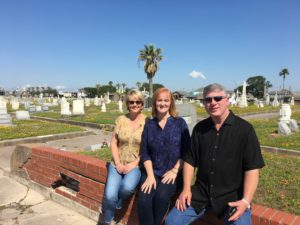 ly asked Bob, “Are you just going to give Kelli the entire segment?”, to which he replied, “I guess I am.”
ly asked Bob, “Are you just going to give Kelli the entire segment?”, to which he replied, “I guess I am.”

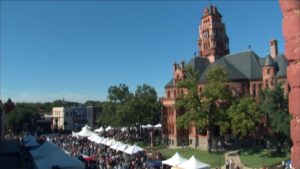 They also invited me (as they do all their on-air guests) to take part in the Texas Country Reporter Festival in Waxahachie on October 28. I’m trying to decide if I really want to have a book booth…or just wander around and have fun talking to people! You can find out more about the festival here: http://texascountryreporter.com/festival
They also invited me (as they do all their on-air guests) to take part in the Texas Country Reporter Festival in Waxahachie on October 28. I’m trying to decide if I really want to have a book booth…or just wander around and have fun talking to people! You can find out more about the festival here: http://texascountryreporter.com/festival
After the Phillips left to go on to the next assignment, we took a lunch break with the plan to meet afterward at the Galveston Texas History Center of the Rosenberg Library. It’s one of the locations that I told the crew from our first conversations was important to include. Their resources are invaluable to any researcher interested in local history.
The Head of Special Collections Lauren Martino and Senior Archivist Sean McConnell were wonderful enough to have pulled a wide variety of maps, documents and photos to represent the types of materials that might be used in my type of research.
Once we finished at the library, Quintin and Dan were heading back to the cemeteries to look for particular types of gravestones to shoot, so I went with them to save them from wasting “searching around” time.
It also gave me a chance to talk to them a bit about how they got started, what the favorite stories they worked on were and why. They get the chance to capture stories of all sorts of people: artists, veterans, craftsmen, storytellers and local characters.
The day before they filmed the Galveston segment, they shot a beekeeper in Houston removing a hive from the wall of a home. They all had to wear the protective gear, but said it was still pretty unnerving.
One laughed an said it was obvious that I was usually on the “other side” of interviews. Well…yeah.
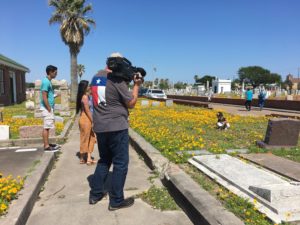 I was also very happy that they filmed its story in late April to catch some of the amazing coreopsis that covers the cemetery complex in May. They may not have been at the height of bloom, but they looked beautiful. And hopefully this adorable little girl will be making a cameo appearance!
I was also very happy that they filmed its story in late April to catch some of the amazing coreopsis that covers the cemetery complex in May. They may not have been at the height of bloom, but they looked beautiful. And hopefully this adorable little girl will be making a cameo appearance!
And just a note…we met at the cemeteries at 7:40 a.m. and left that day at 4:15 p.m. So I probably s-h-o-u-l-d have remembered sunscreen, ha ha!
When Quintin and Dan left they were heading for Beaumont to film the next day. Quintin is single and Dan has arranged to bring his wife along whenever she wants, so they are both at perfect times in their lives for this kind of work. What a great way to see our state.
So when will the segment about Galveston’s Broadway Cemeteries air? We’ll have to be patient. It will be part of the new season in the fall, so I should have an airdate by September. I’ll keep you posted!
In Houston Texas Country Reporter airs on Saturday evenings at 5:00 p.m. on KHOU 11 (CBS). For other market airtime and stations, visit http://texascountryreporter.com/showtimes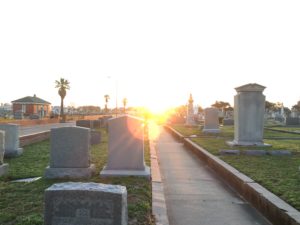
Church of the Osage
When you’re a history buff, visiting historical sites is just part of any well-rounded getaway!
My sister and I just got back from a trip to Oklahoma, where we spent part of every one of our childhood summers. My grandparents’ farm was built on my grandfather’s Indian land grant (he was a Cherokee, born in 1899…but I’ll share more about him later).
On our way to find the farm again, w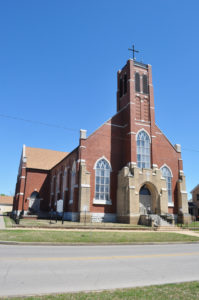 e decided to go to Pawhuska to visit the Pioneer Woman Mercantile and the ranch where Ree Drummond films her Food Network show.
e decided to go to Pawhuska to visit the Pioneer Woman Mercantile and the ranch where Ree Drummond films her Food Network show.
In addition to that, I had heard of an amazing Catholic church in town built by the Osage Indians. The stunning stained glass windows are the feature that draws most visitors to this historic church.
Before we left on our trip, I called the Immaculate Conception Catholic Church, and confirmed that we would be able to take a tour on the day we planned to be in town. The lovely lady who answered the phone assured me that she would be there. If you plan to go, you can also check the ir Facebook page for details.
ir Facebook page for details.
Pulling into the parking lot, there is nothing particularly grand about the exterior appearance of the structure, but the moment we stepped inside it took our breath away.
The 22 windows in the sanctuary are considered to be among the most unusual stained glass of any church in the United States. Traditional Catholic windows feature biblical scenes, and twenty of those found in this church do as well.
The other two, however, depict images of people who were alive at the time the church was erected – which is strictly against Catholic guidelines. The Pope gave special dispensation for these to be created as an acknowledgement of the special relationship between the Osage and the Catholic missionaries.
But I’m getting ahead of myself. First I’d like to share just a bit about the history of the church itself, which is as interesting as its details.
 The church is known in the Pawhuska area as the Cathedral of the Osage.
The church is known in the Pawhuska area as the Cathedral of the Osage.
Knowing that the O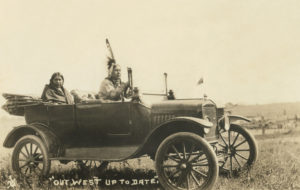 sage in the area may have been the richest people per capita in the world at the time may come as a surprise to many, but definitely explains the exquisite cathedral and its rich details.
sage in the area may have been the richest people per capita in the world at the time may come as a surprise to many, but definitely explains the exquisite cathedral and its rich details.
In the beginning of the 20th century when oil was struck on Osage land, the tribe suddenly went from one of the poorest tribes to the richest.
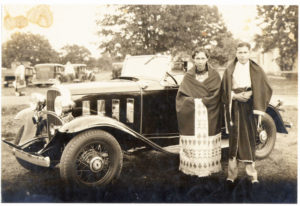
The men are said to have driven the finest cars and simply replaced them if they broke down or got a flat tire. The women of the tribe walked the streets of town with diamonds on their shoes.
Their parish priest at the time was Father Edward Van Waesberghe, who laid out plans and designs for the church around 1910. The priest even did much of the brickwork himself, aided by Osage members.
Inside the church, the ceiling is a series of cross-ribbed arches, painted with a pattern that mimics traditional Osage ribbon work.
Ribbon work patterns also appear as details in many of the stained glass windows.
The altar, draped with an Indian blanket, and statues were made by the same craftsmen who supplied them to the famous Loretto Chapel in Santa Fe, New Mexico.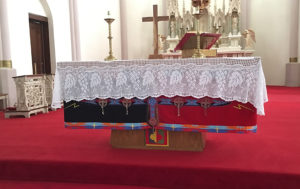
Osage oil money built the church, and enabled the tribe to afford exquisite stained glass ordered from the Bavarian Art Glass Company in Munich Germany.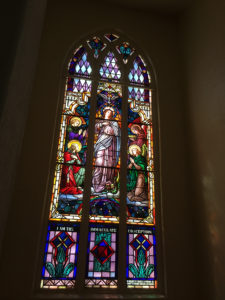
Being created in a country in the midst of World War I held dangers for such fragile masterpieces however, and for a while the German artisans buried the almost completed windows in a local sandy river bank in Munich to protect them from possible shelling.
The artisans themselves traveled to Oklahoma with the 36 foot tall windows, which were shipped in sections to Pawhuska and placed in the church prior to its completion in 1916.
Each of the windows is a stunning masterpiece, with the brilliant red panes achieved through the addition of gold dust.
The two most unique windows in the cathedral feature the images of Native Americans.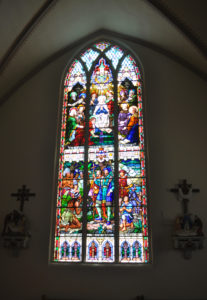
The ‘Columbus Window’ in the south transept depicts the Pentecost scene on the upper panels, and Christopher Columbus’ first encounter with Native Americans in the New World on the lower panels. It was donated by the William S. Mathews family.
Opposite this window, on the north side of the building though, is the exceptional work of art that many travel from around the country (and world) to see in person.
The ‘Osage Window’ portrays the scene of Jsesuit missionary Father John Shoenmakers, known as ‘Black Robe,’ bringing Catholicism to the Osage Nation, at a time when the tribe lived in Kansas before they were moved to Indian Territory. Shoenmakers was held in such high regard by members of the tribe that his name, as Sho-Mink-Ah, is now used as the Osage word for priest.
In addition to the clergyman, the window depicts the images of actual people in traditional Osage dress surrounding the priest, intently listening to the word of God. Many of the tribal members were still alive at the time it was created. They include Osage Chief Bacon Rind, his wife Julia, Chief Saucy Calf, and interpreter Arthur Bonnecastle and his wife. Photographs of those included were sent to Germany along with the order for the windows. This window was donated by Rose Hill, Angie Bonniecastle and T. J. Leahy. 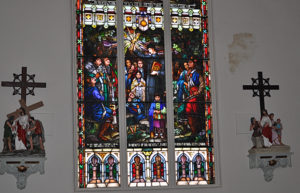
Two adorable little girls stand out from the rest of those pictured, partly due to their stance of staring directly out from the window. They are actual portraits of two young girls who died tragically young from the devastating smallpox disease. They represent the eternal saving power of God’s words to their souls.
Father Shoenmakers worked for 36 years among the Osage until his death in 1883.
A very small room off the vestibule holds the original baptismal font, as well as a partial view of the ‘Expulsion’ window depicting the banishment of Adam and Eve from the Garden of Eden, and the ‘Revelation of St. John.’
Only the lower half of the Eden window is visible however, until one climbs to the organ loft to view the upper half, where musical instruments appear in the design.
The same can be said of the ‘Annunciation’ window in the vestibule on the opposite side, which is partially obscured by the tightly winding steps to the loft. The roses at the feet of Mary glow impressively in the late afternoon sun.
My sister spotted the name ‘Juanita Scott’ on the donor section of one of the window, which made us smile because…although we knew it wasn’t the same person…it was our grandmother’s name.
The remaining windows at Immaculate Conception depict traditional Biblical scenes in a highly detailed and theologically symbolic manner, including ‘The Child Jesus Teaching in the Temple,’ ‘Wisdom, Age and Grace,’ ‘The Wedding Feast,’ and other classic biblical portrayals. Each one is beautifully detailed and worthy of study.
When we asked how many people attended mass there now, the guide responded about 80 to 100 people. For a cathedral of this size, that took us aback. But generations of families have been attending since the church was built, and about 80-90 percent of the parish remains a part of the Osage.
This treasure trove of glass masterworks is definitely worth a detour from any nearby trip route.
Mysterious Symbols Found in the Graveyard
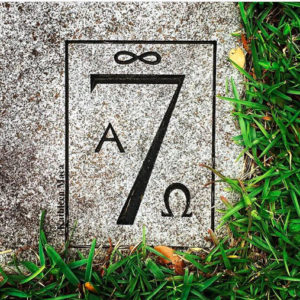 The ‘Nancy Drew’ in me just loves running across gravestone mysteries like this one at Galveston Memorial Cemetery. I couldn’t wait to put on my ‘research hat’ and find out what it means.
The ‘Nancy Drew’ in me just loves running across gravestone mysteries like this one at Galveston Memorial Cemetery. I couldn’t wait to put on my ‘research hat’ and find out what it means.
This particular symbol is a marker for the Seven Society, founded in 1905. It is the most secretive of the Univers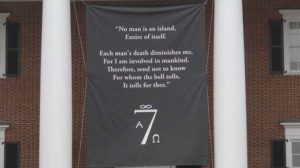 ity of Virginia‘s secret societies. Members are only revealed after their death, when a wreath of black magnolias in the shape of a seven is placed at the gravesite, the bell tower of University Chapel chimes at seven second intervals on the seventh dissonant chord when it is seven past the hour, and a notice is published in the universities alumni news.
ity of Virginia‘s secret societies. Members are only revealed after their death, when a wreath of black magnolias in the shape of a seven is placed at the gravesite, the bell tower of University Chapel chimes at seven second intervals on the seventh dissonant chord when it is seven past the hour, and a notice is published in the universities alumni news.
The only known method to successfully contact the society is to place a letter at the Thomas Jefferson statue inside the university’s historic rotunda. 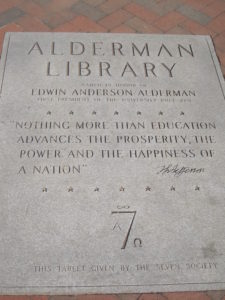
Definitely not a symbol often seen on gravestones on the Gulf Coast of Texas!
Roses for Eternity: Gravestone Symbols
Valentine’s Day isn’t the only day that roses represent love. Some carved in stone symbolize an eternal affection for a lost loved one.
But did you know that how the roses are represented on the grave marker can tell you a bit about the dearly departed?

The rose itself symbolizes love, hope and beauty.
The stage of bloom of the rose indicates the age of the deceased. A bud would have represented a child, a partially opened flower would indicate someone was a teen or young adult, and a rose in full bloom would symbolize the departed had reached maturity.
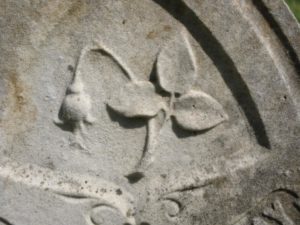
No matter which stage of bloom the flower portrays, the stem is often depicted as broken as a sign that the person was lost too soon – a life cut short.
Two roses joined together stand for a strong bond such as marriage, and often appear on the joint marker of a couple.
A wreath of roses symbolizes beauty and virtue.
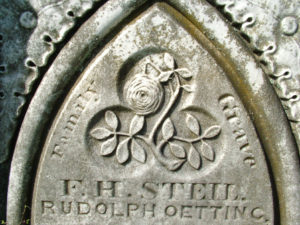 A garland of roses, which may be held by an angel, indicates sorrow, and a bouquet of roses stands for condolences, sorrow or grief.
A garland of roses, which may be held by an angel, indicates sorrow, and a bouquet of roses stands for condolences, sorrow or grief.
So the next time you see the depiction of a rose on a gravestone, take a moment to decipher what information it can share.
Happy Valentine’s Day!
GENEALOGY TIP TUESDAY: Bringing Inscriptions Out of the Shadows
It never seems to fail: you’ve searched endlessly for a particular gravestone, and when you finally find it…the inscription is in shadows with the sun at the back of the marker.
With a little preparation, this won’t be a problem at all.
For years I’ve kept a roll of aluminum foil in the back of my car, along with other “cemetery kit” supplies. Not because I wanted to always be prepared for a bar-b-que (although that might not be a bad idea, either!), but to use to reflect light onto dark gravestones during my spur-of-the-moment cemetery visits.
When the goal was to read or transcribe a marker but not necessarily photograph it, A simple hand mirror from the dollar store also serves that purpose.
This past Christmas my husband gave me a collapsible photography reflector so I could finally retire my box of foil. They are relatively inexpensive, small and portable so I highly recommend getting one.
When used to reflect available light onto the surface with an inscription (plaque, gravestone, cornerstone or other surface), previously illegible information can easily be read.
Watch the video for a quick demonstration of how easily and well it works.
The “Great Snow” of 1895
Today’s icy weather is definitely not the norm for this part of Texas. Our streets, tires and infrastructure is designed to handle heavy rains and heat, but not snow.
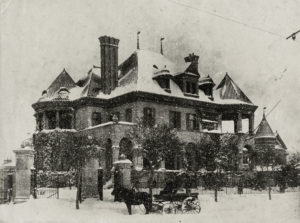
But because it’s such a rare occurrence, photos of snowfalls from the past seem especially enchanting. On Valentine’s Day in 1895 Galveston was blanketed with over a foot of snow, bringing street car traffic to a halt, and closing the doors of banks and wholesale businesses.
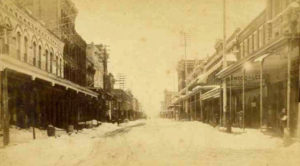
The snow began to fall about one o’clock in the afternoon, and continued to fall for the rest of the day.
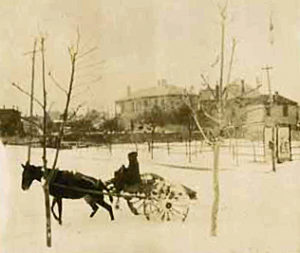
Shoes stores sold out of “gum boots” (rubber boots) and overshoes, as even the most sedate citizens took part in citywide snowball fights. Merchants, policemen, bankers carriage drivers, doctors an other adults took the opportunity to launch snowballs at each other, to the delight of onlookers.
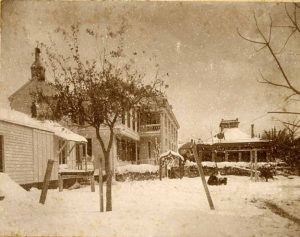
Those trapped at the train station waiting for trains that had no way of reaching them were less amused. The bright spot at the station occurred when Officer Perrett saved a yellow dog he found half-frozen in a snow drift, and warmed it by the waiting room stove.
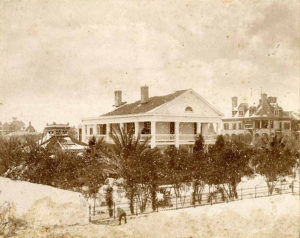
A few ingenious locals attached temporary runners on their carriages and used them as makeshift sleighs. Others were the victims of icy falls and other mishaps.
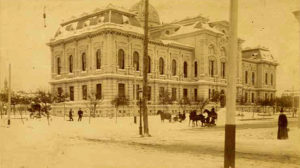
As evening fell Dr. Isaac Cline, the now famous Galveston meteorologist was busily answering telephone inquiries about the prospect of more snow, but were met with the news that the “worst” was over. Our generation isn’t the first to be excited over the prospect of snow or worry about it’s implications…and it certainly won’t be the last.
Photographs courtesy of the Rosenberg Library Archives.


